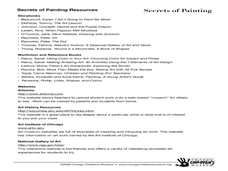National Gallery of Canada
Artful Emotions
Blue is sad, and red is angry, but why is that? Young artists explore the expression of emotions through art by observing and creating artwork. Starting with a questioning session about images of art, this plan moves into a sculpture...
National Gallery of Canada
Transformation
Create colorful cool or warm butterflies with simple materials. Class members draw their designs, spray the marker to diffuse the colors, and attach pipe cleaners to form the shape of a butterfly with antennae. Individuals must be able...
National Gallery of Canada
Home Sweet Home
What are your pupils' homes like? Incorporate their homes into a drawing instructional activity. Using an enlarged photograph, class members draw a grid so they can easily split their drawing in half. The final product should demonstrate...
Curated OER
Two Layer Painting
With a little extra tag board and some tempera paint, learners can explore warm and cool colors. They create a two layered drip painting where they focus on mixing both cool and warm colors to achieve a fascinating effect.
Curated OER
Secrets of Painting
Students explore colors and shapes. In this art concepts lesson, students discuss shapes, lines, and color while creating a variety of abstract designs. The instructions for several art activities are provided. Basic art vocabulary and a...
Curated OER
Warm Colors vs Cool colors
Students discuss the difference between warm and cool colors. They discuss things such as mood, seasons. Also, students take an imaginary trip inside of their bedrooms to figure out their bedroom is warm or cool in color. Students...
Curated OER
Warm/Cool Leaves
Students examine the difference between warm and cool colors. They discuss the basic color wheel, reviewing primary, secondary and complimentary colors. An activity allows students to discover how to mix the warm and cool colors.
Curated OER
ART- LANGUAGE OF SYMBOLS
Students discuss how color construct meaning in art. They will demonstrate a technical knowledge and creative use of formal elements and principals of design. Students then discuss the way their selection of color contributed to their work.









